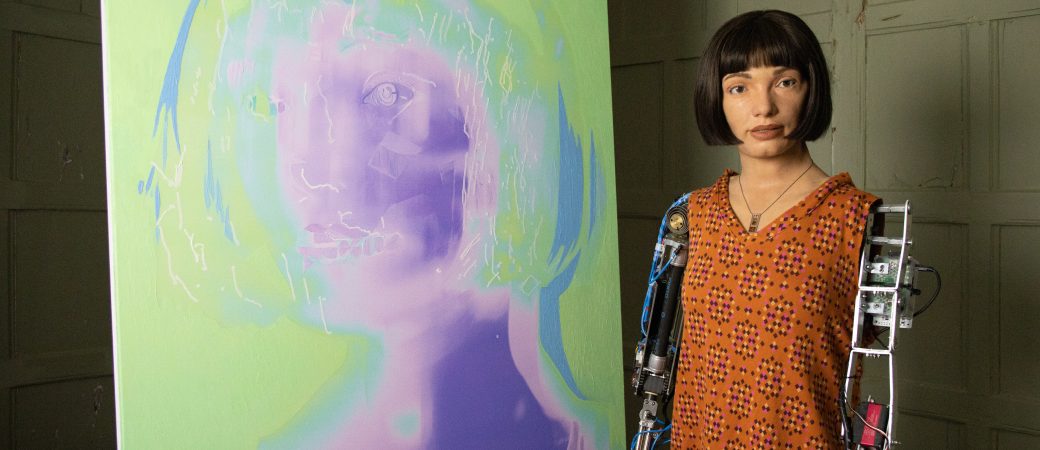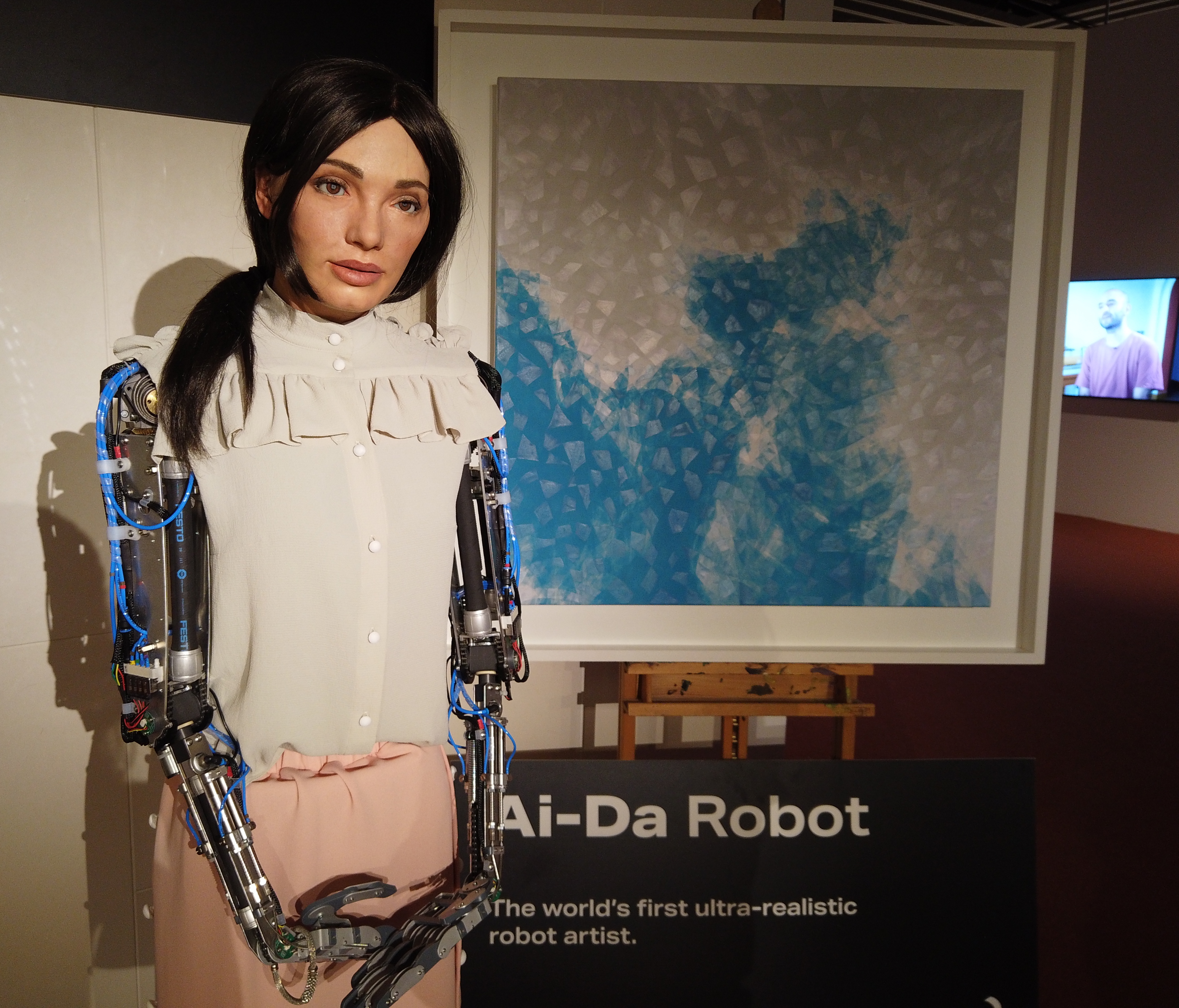
di Federico Simonetti (Independent Researcher).
In October 2021 “virtual artist” Ai-Da was arrested by Egyptian authorities, who claimed that it was some kind of sophisticated weapon or spying technology.
Ai-Da is an artificial intelligence (AI) software, specifically developed to execute artistic portraits, connected to a human-like robot that can draw these portraits: it captures the subject with its “eyes”, and then draws the scene thanks to a robotic arm.

Ai-Da entered Egypt due to its participation in the “Forever is Now” contemporary art exhibition, organized with the collaboration of the Ministry of Antiquities and Tourism and the Ministry of Foreign Affairs near the famous pyramids of Giza. One of the works on display was a sculpture created by Ai-Da. Before the start of the exhibition, however, both Ai-Da and his sculpture were blocked at customs at Cairo airport for ten days due to “security problems”.
This apparently ironic fact caused a lot of curiosity and ridicule among the international public, especially in regards to the rigidity of the bureaucracy and the “backwardness” of Egyptian authorities. It also caused a certain subtle bewilderment in the face of a somewhat uncanny subject. Like many robotic objects, Ai-Da arouses in the viewer a feeling of bewilderment, which Masahiro Mori in 1970 defined as “Uncanny Valley”, basing on the Unheimliche Freudian topic. Ai-Da, in fact, is not only capable of creating objects of art, but it does so by exhibiting human traits (a human face, human-like eyes, etc), in some way pretending to be human: in this way, Ai-Da slips into that rift between human and machine that generates disgust rather than wonder.
This uncanny element, however, probably does not emerge for the right reason, in this case: Ai-Da is uncanny because it pretends to be human, while what it actually does – that is, processing images taken through a camera and reproducing the result through robotic arms – is not at all different from what happens on our smartphones, using apps like portraitAI. Not surprisingly, the “robot artist” was arrested because in its head there is a modem that constantly communicates with a neural network, which is the real “author” of the portraits that the robotic arm draws: Egyptian police feared that this modem could steal confidential information, especially during an exhibition in which the country’s top institutional officials were invited.
A neural network is a mathematical model composed of “artificial neurons” inspired by biological neural networks (human or animal) and is used to solve engineering problems of Artificial Intelligence related to different technological fields such as computer science, electronics or other disciplines – as art production.
Neural networks make computers able to solve problems independently from human intervention and improve their capabilities. The need for initial training by human agents depends on the artificial intelligence method used, but is common practice in the vast majority of approaches. In short, a neural network is a set of micro-calculators (“neurons”) which process a little slice of a problem and assign it a value: collecting and processing all the values in the network the Artificial Intelligence comes with an answer to the bigger problem that otherwise would be unbearable for a single algorithm.
Let’s make an example: neural networks can be used for image recognition. Unlike humans, a computer is unable to recognize whether an image depicts a human, a plant or an object, but must examine the individual characteristics of the figure. Either the computer knows which characteristics are relevant thanks to the algorithm implemented, or it can find out by itself through data analysis.
Instead of considering the picture as a whole, the neural network divides the picture in pieces and assigns every piece to a “neuron” which has to assign a value of probability to what is inside: how probable is that this is a human trait from 1 to 10? Collecting all the values for all the pieces of the image, the network comes to a decision that will go into a database of matured knowledge.
Initially, the results will be relatively error-prone. If the neural network receives feedback from a human trainer and is able to modify the algorithm, it is called machine learning. In deep learning, human training can be omitted. In this case, the system learns from its own experience and becomes all the better the more visual material it has available.
Ideally, the end result is an algorithm that can identify image content without error, regardless of whether these images are in black and white or in a certain pose or perspective.
The neural network is the core part of Ai-Da, its “soul”, disconnected from the body, the part that would continue to exist, even if the robot is arrested or “killed”.
The Egyptian police just arrested the robot part of Ai-Da, which is nothing more than a very complex version of a printer (when drawing) or a 3D printer (when sculpting), connected to a remote server doing some editing on pictures. In itself, it doesn’t make much sense that it causes concern. What remains watching Ai-Da, however, is a deeper sense of disorientation: why is this modern version of the Automaton Chess Player allowed to enter a museum and be awarded the title of artist? What does this fact say about us, about our epoch, about art in our highly technological age?
Ai-Da’s creator is Aidan Meller, an Oxford gallerist specializing in modern and contemporary art: for him, after all, the invention and development of Ai-Da is a “provocation” needed to raise a discussion around the presence of artificial intelligence in art, to report and warn about abuses of technological development in the artistic process. At the same time, Ai-Da’s works are exhibited, sold and bought as if they were works of art that retain their aura, which have the status and credibility of true works of art. This story should probably make us reflect on the status of human beings in the era of their technical substitutability: when even artistic production can be automated, and no one notices the difference, isn’t it probably because the human public itself is increasingly losing a human gaze and assuming a mechanical gaze?
On one hand, today we rely on AI systems to perform increasingly complex functions, often linked to our mere pleasure: it should therefore not surprise us too much that AI is also used to make art, that it helps artists like a brush helps the painter or a sander helps a sculptor. These automata are able to “help” the artist in a way that risk to replace the artist’s own creative effort: art and technique have always been strongly connected, but the era in which we live – which replaces all know-how-to-do and know-how-to-live with technological tools – risks making not only art, but every other aspect of spiritual life more and more in-human.
On the other hand, AI are often perceived as a threat due to the risk of them becoming smarter than humans and rebelling: it is a remote possibility, for now, and a rather low risk. The problem, unfortunately, is that they stay “dumb”, but that human as a species become dumber than them. In this sense, artificial intelligence won’t need to beat human intelligence: it will be sufficient to beat natural stupidity. Imposing ever lower labor costs is already forcing companies to rely on increasingly automated solutions that no one actually has control or knowledge of: society, consumers, today notice the difference and do not always appreciate it, but software quality and refinement will soon reach a sufficiently acceptable level, determining AI triumph.
After all, what should worry us about Ai-Da’s arrest is not so much the stupidity of the Egyptian police or how unnatural it is for an in-human robot to be treated like a “real” artist. The point is how much, in our era, the tool (technology) is increasingly replacing the process (creation), how much the result (the work of art, in this case) is completely replacing itself for the purpose ( the ability to express oneself). And this is the truly disturbing element of our age.
 Stampa questo articolo
Stampa questo articolo
